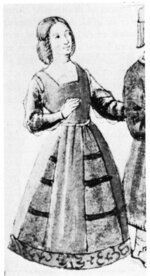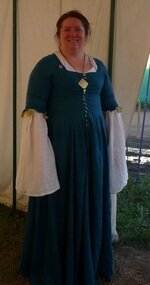I actually started this project in August, but due to some issues with the website - including switching name providers - I'm just now starting the diary.
Our household is going in full 5th/early 16th c. Spanish this year, which is just my thing. I started looking for something really weird, really really typically Hispano-Flemish. I found the following image on Mistress Jessamyn's website; while it did not have a date attached, the split overskirt and sleeves helped me date it to about 1470-1500.

The image is of a female demon tempting a saint - you can tell she's a demon by the chicken feet sticking out from under her skirts. I want to create a set of gowns that will replicate this outfit as closely as possible. Because the original image I'm working from is a very damaged plaster fresco, many of the details are obscured. This means that I'm flying blind on a lot of the specifics. However, there are some hints that I can use to piece together a reasonably accurate ensemble.
Although the detail on the undergown is patchy and indistinct, some quick research in the ubiquitous Hispanic Costume reveals that the split overskirt was most typically worn over a verdugado (hooped gown). Here's an example:

This example probably depicts a saya verdugado (a hooped skirt attached to a bodice with a waist seam) or possibly the hooped skirt without the bodice, under a brial (dress without a waist seam) with split skirts (Anderson 208).
Another example, the figure of Reason from Alfonso de la Torre's Vision delectable, is shown wearing "a rose colored skirt...divided into four over an apple green underskirt, which is banded in blue-green and hemmed with a gold band figured in black" (Anderson 208).

Interestingly, the silhouette of the first exmaple, with hoops, has a distinctly flattened conical shape to the skirt, while the description of Reason's dress- which hangs roundly conical as one would expect a hoop to hang- doesn't mention hoops at all. Despite this, no other undergarments appear in Anderson that could account for the rather stiff drape of the skirts.
My plan at this point is to build a sleeveless saya verdugado as the foundation garment, with a sleeveless split skirt saya for the overgown. Both gowns will have a low, square neckline as is typical in fashions of the time, and the overgown will have a band of trimwork around the neck. The sleeves will be completely seperate, fastened together and to the gown with ties.
For the undergown, I've chosen a pale gold silk dupioni, lined with yellow linen and banded with dark apple green velvet ribbon for the hoop casings. The bodice will be interlined with linen canvas, since the silk I have purchased is extremely lightweight and cannot serve as a supportive garment without both a lining and an interlining. The hoops are standard 3/8 inch half oval basketry reed.
The overgown is a dark wine red cotton velvet that I've had in my stash for years, lined with a lightweight black linen. The trimwork around the neck is also from my stash, as is the silk thread for the sleeve ties.
I haven't chosen a fabric for the sleeves yet; my choices at the moment are:
1. burgundy velvet lined with gold silk (matches the gowns)
2. black velvet lined with pink silk (sample from Pennsic classes and already finished)
3. Gold on red brocade with some other lining
For accessories, I have several silk sashses to choose from as well as a half-dozen cofi y tranzados to cover my hair. A large enameled pendant from Raymond's Quiet Press, a pair of pearl drop earrings, and my green and black cowmouth shoes should round the whole out well.




